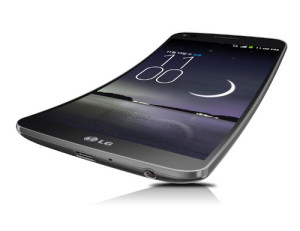 After a long, leaky build-up, LG has officially debuted its curvaceous smartphone, the LG G Flex. Remember where you were this day; for it will go down in history as the date when LG’s mobile devices began to slightly bend for no demonstrably necessary reason.
After a long, leaky build-up, LG has officially debuted its curvaceous smartphone, the LG G Flex. Remember where you were this day; for it will go down in history as the date when LG’s mobile devices began to slightly bend for no demonstrably necessary reason.
First, we should mention that despite its name, the G Flex is not actually “flexible.” The phone boasts a slight static curve from top to bottom. The company claims the curve provides a number of comfort benefits, such as following the rounded contour of the human face and fitting more snugly in one’s back pocket.
LG also claims that in landscape mode, the curve will add a more immersive “IMAX-like” experience for watching videos or playing games. In addition, the curve naturally reduces “the distance between one’s mouth to the microphone.” (Was there a mouth-to-microphone distance problem I was unaware of?)
Spec-wise, the Flex is basically a curved version of the LG G2. Both phones sport a six-inch display and single-button-control “Rear Key” design. Both are powered by a 2.26 GHz Quad-Core Qualcomm Snapdragon 800 chipset. Both run on Jelly Bean and even share the same specs on their front and rear cameras (13MP and 2.1MP respectively).
The G Flex has even commandeered the G2’s signature new UX feature, “KnockOn,” which allows users to wake up the phone by tapping twice on the screen with their finger.
Aside from its unique Pringles chip-like shape, the G Flex can claim one additionally all-new feature: A “self healing” coating. LG claims the elastic material on the back cover gives the phone “the ability to recover from the daily wear-and-tear scratches and nicks” that uncased phones face. While LG’s PR team would surely like us to believe this self-healing coating gives devices Wolverine-like regenerative powers, we should probably wait until the actual device get into reviewers’ hands and testing labs.
Curvy Competition
LG’s official release dubs the G Flex the “world’s first real curved smartphone.” The inclusion of “real” is a grammatical shot at rival Samsung’s curved Galaxy Round handset, which debuted earlier this month. For now, the Round is a strictly limited release that is only be available in Korea (though our sister news network was able to score a hands-on, which you can read about here). Meanwhile LG promises that the G Flex will first come to Korea in November followed by additional markets that will be “announced thereafter.”
From the look of things, Samsung had neither the ability nor intention to bring the Galaxy Round to mass market. However the limited release allows the company to claim it produced the very first curved smartphone, leaving LG to settle for claiming it released “the first real curved smarphone.”
While most consumers will probably never get their hands on the Galaxy Round, Samsung’s take on the curved phone did take some advantage of the new form factor. Users could tip the phone along its curve to check notifications and time on their phone, utilising the so-dubbed “Roll Effect” function. Meanwhile, the G Flex doesn’t appear to take direct advantage of the phone’s new shape, which seems like a missed opportunity.
In their current incarnations, curved handsets don’t bring anything new to the mobile party. Are their really any consumers who are really perturbed by the way a flat phone feels against their cheek? None that I’m aware of. However, the real take away may be that manufactures have the ability to design mobile devices in a whole new way. While neither the Galaxy Round nor G Flex will set the mobile world ablaze, their real contribution may be setting the foundation for possibilities further down the line.





